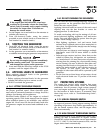
14 Generac
®
Power Systems, Inc.
• Immediately wash with water all skin areas that
come into contact with the electrolyte.
• If the electrolyte contacts the eyes, immediately
flush eyes thoroughly with water, and seek med-
ical attention.
• Spilled electrolyte is to be washed down with an
acid-neutralizing agent. A common practice is to
use a solution of 1 pound (500 grams) bicarbonate
of soda to 1 gallon (4 liters) of water. The bicar-
bonate of soda solution is to be added until the
evidence of reaction (foaming) has ceased. The
resulting liquid is to be flushed with water and the
area dried.
3.7 COOLING SYSTEM
Air intake and outlet openings in the generator com-
partment must be open and unobstructed for contin-
ued proper operation. Avoid obstructions, such as,
high grass, weeds, brush, leaves, and snow.
Without sufficient cooling and ventilating air flow, the
engine/generator quickly overheats, which causes it
to shut down.
3.8 ENGINE COOLANT
Check the coolant level in the coolant recovery tank
at least once daily or prior to use. Add the recom-
mended coolant mixture (see Section 1.5.4, Page 6),
as necessary; the tank should be kept within the lev-
els indicated on the adjacent decal. If desired, you
may add a high-quality rust inhibitor to the recom-
mended 50-50 coolant mixture. If added consistently,
the recommended mixture will protect the unit
against freezing temperatures.
Periodically remove the radiator pressure cap, locat-
ed behind the access cover above the user control
panel, to make sure the coolant recovery system is
functioning properly. Coolant should be at the bottom
of the radiator filler neck. If the coolant level is low,
inspect the gasket in the radiator pressure cap.
Replace the cap, if necessary. To have the pressure
cap tested, contact a Generac Authorized Service
Dealer. Inspect both the cooling system and coolant
recovery system for leaks.
Do not remove the radiator pressure cap while
the engine is hot; otherwise, serious burns
from boiling liquid or steam could result.
Ethylene glycol base antifreeze is poisonous.
Do not use your mouth to siphon coolant from
the radiator, recovery bottle, or any container.
Wash your hands thoroughly after handling.
Never store used antifreeze in an open contain-
er because animals are attracted to the smell
and taste of antifreeze, even though it is poiso-
nous to them.
Do not use any chromate base rust inhibitor
with ethylene glycol base antifreeze; other-
wise, chromium hydroxide (“green slime”) will
form and cause overheating. Engines that have
been operated with a chromate base rust
inhibitor must be chemically cleaned before
adding ethylene glycol base antifreeze. Using
any high-silicate antifreeze boosters or addi-
tives will also cause overheating. We also rec-
ommend that you DO NOT use any soluble oil
inhibitor for this equipment.
3.9 MAJOR SERVICE MANUAL
To obtain a service manual for your generator, con-
tact Generac or your nearest Generac Authorized
Service Dealer. Make sure to identify your MODEL
NUMBER and SERIES.
3.10 DRIVE BELT
The engine drives the generator rotor by means of a
pulley and drive belt arrangement. Drive belt tension
was properly adjusted before the unit was shipped
from the factory. If you suspect that drive belt tension
is incorrect, contact a Generac Authorized Service
Dealer.
3.11 EXERCISING THE GENERATOR
Generac recommends that you start and operate the
generator at least once every seven days. Let
the unit run for at least 30 minutes to “exercise”
the engine. If you cannot exercise the generator every
seven days, and it is to be out of service longer than
30 days, see Section 3.12.
3.12 OUT-OF-SERVICE PROCEDURE
3.12.1 REMOVAL FROM SERVICE
Prepare the generator for storage as follows:
1. Start the engine and let it run until it is thor-
oughly warmed up (at least five minutes), then
shut off the engine.
2. While the engine is still warm from running,
drain the oil completely (see Section 3.2, Page
12). Refill the crankcase with the recommended
oil (see Section 1.5.3, Page 6).
3. Attach a tag to the engine, indicating the viscosity
and classification of the oil in the crankcase.
4. Remove the battery and store it in a cool, dry
room on a wooden board. Never store the battery
on any concrete or earthen floor.
5. Clean and wipe the entire generator.
◆
Section 3 – Maintenance
QUIETPACT™ 65D Recreational Vehicle Generator


















